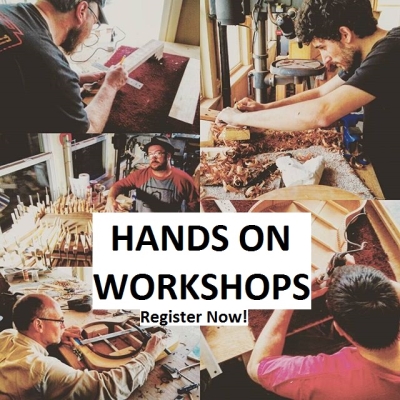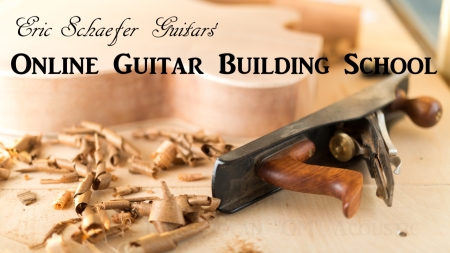A decorative end wedge hides the seam between the sides at the lower bout. This video excerpt from the Online Guitar Building School goes into detail about design considerations and the process for creating a clean and attractive endwedge.
Video Transcript:
Okay, the sides are looking pretty good at this point.
The addition of a decorative endwedge will make the
seam at the lower bout disappear and it will carry the
design motif that you’ve established with the rosette
to other parts of the guitar.
I clamp a board so that it overhangs the workbench and
hang the sides on the board with the lower bout seam
facing up.
I mark the center at the top and bottom of the endblock
and carry both of those centerlines onto the side with a
square.
By squaring the centerline onto the sides from both the
the top and bottom of the endblock, you may notice that
you get two centerlines. This is a relatively common
occurance.
It simply means that at some point during
radius sanding you sanded a little heavy to one side or
the other and now the endblock is out of square, like
you see here. This is not an issue. Just know that you’re
true center is directly in the middle of those two lines.
It should also be mentioned that the seam between the
two sides is not a reliable measure of center.
Now let’s make the endwedge. I use the same material
that I used for the rosette. I find a section of the
material that I am using that has similar grain and color.
That’s where I will mark out my endwedge.
I use a straightedge to make two converging lines with
the grain or any interesting banding running relatively
straight down the center between those two lines.
The taper can be dramatic or slight. It is a matter of
taste. Just know that, in order to use this method,
you cannot have no taper at all. The wedge shape of the
aptly named endwedge has an important functionality
when it comes to fitting and gluing it in place.
I cut out the endwedge on the bandsaw, staying 1/16″
outside of the line.
The endwedge can now be planed down to the line on
the shooting board with a block plane. Keep in mind that
it is best to shoot the plane from the wide end of the
taper to the thin end, to avoid catching the grain and
tearing out.
I’ve decided which face I want to be the show face and
now I flip the endwedge over to find and mark the
centerline on the opposite face.
To make a lengthwise centerline on a tapered wedge,
first I make 2 parallel lines. I find the center of each line
and then connect the those center marks with a straight
edge.
I use double stick tape and 2 cam clamps to hold the
endwedge in place.
I carefully line up the centerline of the endwedge with
the centerline on the sides and clamp it in place.
I use the endwedge as a fence for making a saw cut
on each side. A fine toothed dovetail saw or, in this
case, a japanese dsouki saw, make the cuts. Take your
time setting the cut and be very careful not to
inadvertently skate off the line. The goal is to cut all
the way through the glue line of the sides until
I reach the endblock. If I cut a little bit in to the
endblock that’s okay.
Now I move the clamps to the other side so I can
make the second cut. This is why I used the double
stick tape. So the endwedge doesn’t lose its place while
I move the clamps.
Once the two outside cuts are made,
I heat up a spatula and remove the double stick tape
Now I make several cuts to the inside so that
the material can pop out with a chisel.
These cuts are quick, rough cuts so I use a piece of scrap
as a fence rather than risking damage to my endwedge.
I adjust the fence for another cut. Every cut should be
about 1/8″ apart.
I make sure that all the cuts extend past the glue line
and into the endblock atleast a little bit. The material
comes out cleaner if the cuts are through the glue line.
I use a cam clamp as a backstop. The backstop not only
keeps the sides from moving around, it also creates
support for the first row of woodchips that I will remove
with the chisel. Without the backstop, the first row
would likely tear out onto the top surface of the
endblock. I simply press the chisel along the grain lines,
being very careful not to mar the outside saw cuts.
At this point the recess that you’ve created should be
fairly rough. I clean it up a little bit with a chisel,
however, you can easily damage the clean edge of the
outside saw cuts, so be careful.
Since the endwedge is aesthetic and not structural
in any way, I am not concerned with getting a perfectly
flat and smooth bottom.
I slightly round the edges on the glue face of the
endwedge so it doesn’t get hung up in the corners.
Now let’s check the fit…
It’s a great fit… but the two woods are so similar
in color that I believe something needs to be done
to create some contrast.
Thin wood strips can be ordered in various colors from
luthier suppliers. I can slide a wood strip in place and
see if I like the contrast of color.
That looks pretty good… but let’s see what it looks
like with a white strip.
The white strip looks great and it will fit well with the
binding that I’ve chosen to use later.
I break apart the white strip so that it overhangs the
endwedge recess slightly.
…I do the same thing on the other side.
Now we are ready for glue.
I mark with a pencil where the endwedge overhangs,
simply so I know not to spread glue in those areas.
I make sure I spread a little glue on the edges as well,
especially if I am adding wood strips to the design.
2 spring clamps apply downward pressure.
Now I make a pencil mark on the endwedge where it
meets the edge of the side.
I tap the endwedge a few times with a hammer, lightly,
to wedge it in place.
The pencil mark should move just slightly, indicating that
the endwedge has moved just slightly and now is properly
wedged.
I let this dry for atleast 45 minutes.
Now to remove the excess…
First I trim the wood strip with a razor knife.
A flush cutting saw works best for removing the overhang
because the saw’s teeth are angled up slightly, so you
don’t mar the surface of the endblock. Other saws or
methods can be used as long as you are careful not to
mar the endblock.
It’s not a bad idea to place a clamp over the endwedge
while you cut, so you don’t accidentally force the
endwedge loose.
When you selected the wood for the endwedge, hopefully
you selected a piece that is thicker than the side
thickness and now the endwedge is sitting proud of the
surface.
I level the endwedge with a block plane until it is close
to flush.
Then I switch to sandpaper on a flat block to bring it
completely flush.
Let’s sand it to 220 grit just to see what it will look like
all smoothed out.
It is important that the endwedge is either perfectly flush
or a little shy of the glue surfaces for the plates.
I carefully use a chisel to trim down any material that the
flush cutting saw didn’t get. To be on the safe side, I will
trim the endwedge a little bit shy of the surface. Any gap
that results from this will be removed later
when I add binding.
Notice how I handle the chisel in a way that keeps the
chisel’s edge away the endblock so I don’t mar that
surface.
Okay, the endwedge is ready for it’s debut. I take the
sides out into the natural daylight and rub mineral spirits
on the area. Mineral spirits roughly mimicks the
effects of finish so you can get a glimpse of what
the end product will look like.

